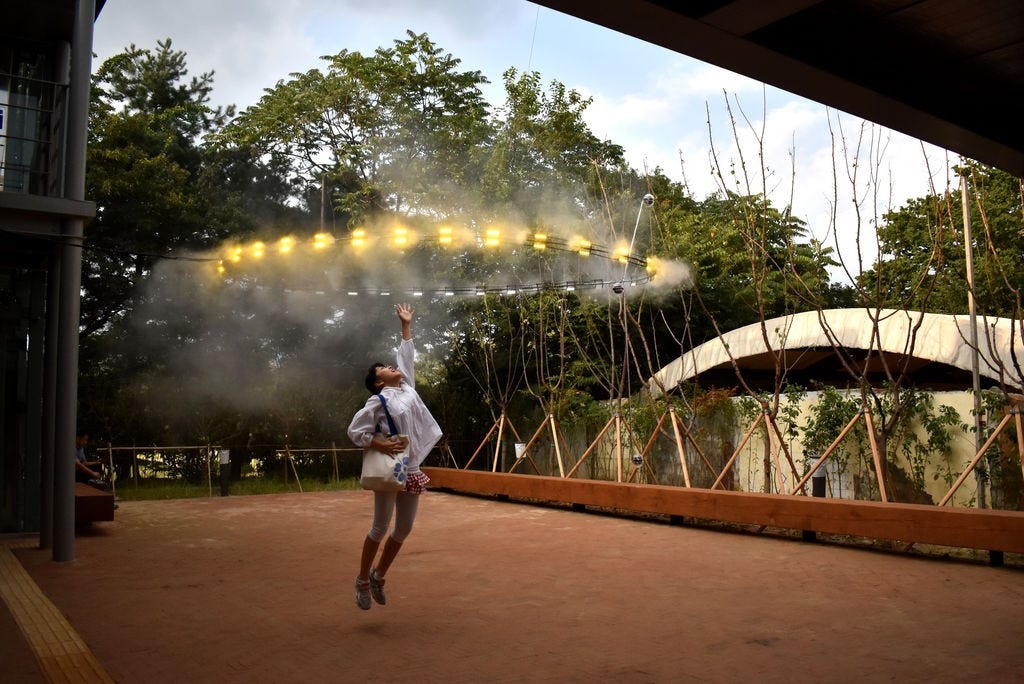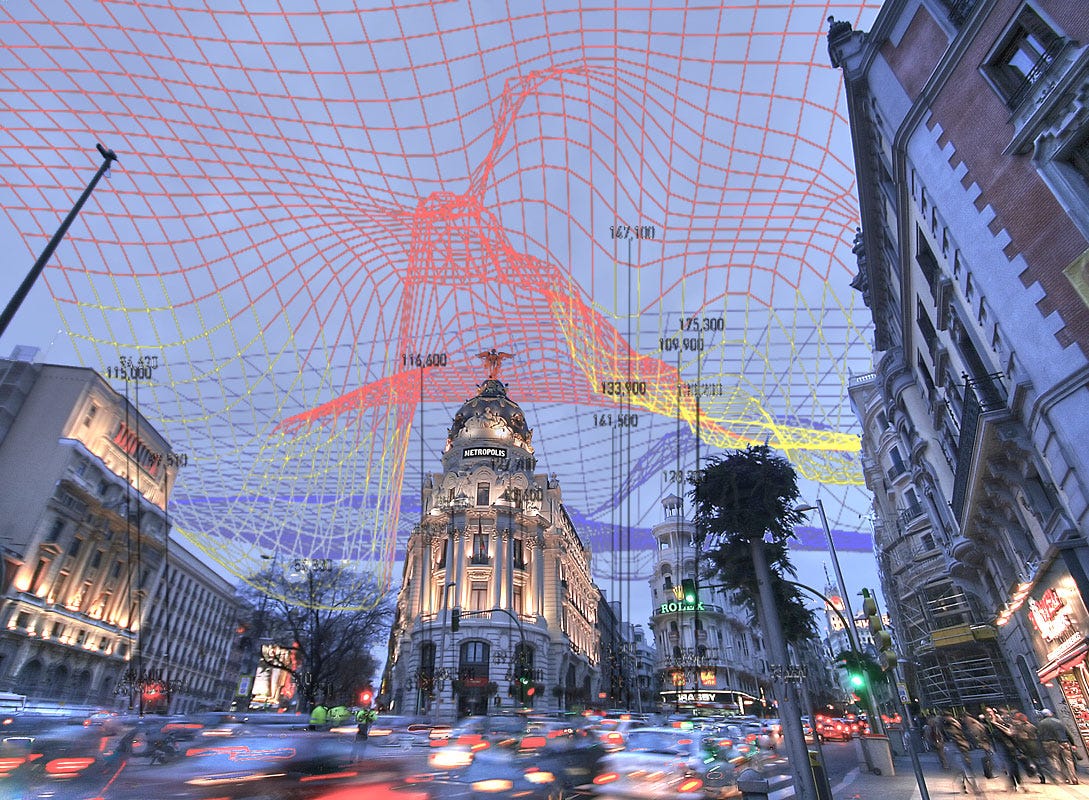An interdisciplinary exploration of the air and atmosphere which surrounds and sustains us, showing how such ecosystems are, in fact, plural, interdependent, and indeterminate
📚 You can buy any book featured in this newsletter from my page on Bookshop.org
🇸🇪 If you are interested in technology and its impact on planetary ecologies — watch my recent talk, “Human Decentered Design” which I delivered a few days ago at The Conference, Malmö

Ecology feels like an insurmountable subject. Climate problems facing the world dwarf our existence, meaning that we are pushed to imagine how to “fix” planetary ecosystems, cleanse vast oceans, or rewild huge tracts of land. We grapple with how our personal consumption can be tamed to benefit bees and birdlife.
In Aeropolis: Queering Air in Toxicpolluted Worlds, Nerea Calvillo takes us on a journey that is equal parts academic and speculative, demonstrating her written and artistic vision for living more in tune with “the airs” that surround us; what she terms “[paying] attention to the differences in and within the air” (pg. 26). Calvillo’s writing is interspersed with sketches and observations of her life in London and Madrid.
Our introduction to Aeropolis starts with her reflections on the view from her window. The clouds, swirling atmosphere, and particles stuck to the window gesture towards future chapters where she explores the necessity of de-in-vizibilizing these airs — as a literal intervention and empirical investigation — to reframe how we make sense of our damaged atmospheric ecology.
For economic, sociopolitical, and sometimes selfish reasons — we are encouraged to conduct environmental interventions as both a personal and transactional activity: if I turn off this light or recycle these straws, the planet will benefit.
Calvillo’s interdisciplinary approach is deliberately transgressive. Chapters are interspersed with photo scrapbooks. We are asked to consider the implications of queering our understanding of planetary ecology, and shown how this is central to gesturing towards new mental models for realising ecological interventions:
“Aeropolis is a world-making project. It aims to be propositional, to imagine, design, and construct space, theoretical ands physical, anew — space that is intersectional, transfeminist, and queer. It is a framework that lets us experiment with how to live in this toxic polluted and these troubled times” — Aeropolis, pg. 53
There is a growing body of interdisciplinary ecological writing that explores how technology and humanity have an interdependent and connected existence with the planet — urging an adaptive and sensemaking ideology, instead of the individualised, solution-seeking activities that dominate corporatised environmental change.
Yellow Dust

Calvillo makes the exploration of “seeing information about air pollution, [and if we can] collectively sense it” (pg. 169) central to this book. In Yellow Dust, a project situated in Seoul, we are guided through the thought process that asks how we define clean or dirty air: How are these distinctions made? And how do these particles interact with other entities in the city? So much of current environmental thinking leans towards transactional interventions or one-dimensional measures — such as air quality monitoring at fixed locations. In Yellow Dust, the airs of the city come alive as the illuminated mists swirl and move; shining a spotlight on how our airs are shared, and so, ultimately, are our responsibilities.
“Air refers to different things across different forms of knowledge and is enacted in multiple ways. It is a milieu, a gaseous chemical composition, a public health threat, a landscape, an invisible flow, and experience, an ontology, a weapon, a classical element.” — Aeropolis, pg. 22
Aeropolis also draws on some of Calvillo’s earlier projects, such as In the Air (2010) where she visualises the movement of invisible air particles in Madrid, as a way of getting a better understanding of how they interact with other invisible airborne particles plotted on the city map — underlining the prescience of art led, cross-disciplinary interventions in the face of public and global health atmospheric concerns now familiar after the Covid-19 pandemic.

Clean or dirty. Pure or toxic. So much of ecological thinking is defined by rigid binaries — influencing how we make sense of the flora, fauna and fungi across the planet.
When winds lift sand from the Sahara desert to turn European skies pink, popular discourse frames these occurrences as an invasion of foreign particles. Calvillo goes on to note that “... what counts as ‘otherness’ depends on how the relationships between the body, nature, and the built environment are conceptualized, and how the boundaries or the skins between them are constituted” (pg. 98). These thoughts chip away at rigid systems of classification, place and belonging, that make sense for the geopolitical project of bordering, and bodily control; but such constrictions lose their persuasive power when applied to restricting the movement of airborne particles.
Aeropolis outlines why we should consider the deconstruction of these inflexible mental models, and accept the airs that surround us, not only as externalised matter with which we interact in a transactional way, but as part of a complex ecosystem that requires “collective sensing” in how we measure, visualise and respond to the changing airs.
Concerning ecology

Calvillo’s research and art refocuses our gaze towards the smallest particles of our planetary ecosystems — encouraging us to conceive of the air we breathe as the building blocks that are both a source of life and a symbolic presence embodying our interdependence with other entities.
For technologists and digital designers, ecosystems are useful metaphors for communicating the complexity of our work and functions to defend the inscrutability of our labour. We ought to return to the word’s original meaning because the impact of technological expansion is already causing huge environmental damage.
“What does it mean to radically decenter the human, to put the material composition of air at the center instead, to pay attention to their agencies, to recognize their diversity, and to focus on the microscopic and the invisible?” — Aeropolis, pg. 45
Last week, I spoke at The Conference in Malmö about the need to decenter humans in design. The ideas explored in Aeropolis align with some of my ideas for radically displacing the extractive, exploitative dominance enacted through technological innovation that humans have unleashed on the planet.
In Aeropolis we are shown a reparative approach to understanding ecology by restoring the richness of Black, Brown, Indigenous, queer, and feminist ecologies — which not only troubles the problematic framing to which we often cling: of clean vs. dirty, or invasive vs. foreign. Instead, Aeropolis sets out a clear vision for how we can intervene in ways that are adaptive and sensemaking, rather than transactional and individualised.
Aeropolis: Queering Air in Toxicpolluted Worlds by Nerea Calvillo. Published in 2023 by Columbia Books on Architecture and the City, 285 pages.
More from Nerea Calvillo
C+ arquitectas is the architecture, spatial design, and research practice started by Nerea Calvillo, where many of her past art, academic, and research projects are presented. Today, Nerea is associate professor in the Centre for Interdisciplinary Methodologies, at University of Warwick, from which her current research projects are shared.
Yellow Dust questions the ways in which we visualise and understand air pollution. The installation was exhibited as part of the Seoul Biennale of Architecture and Urbanism in 2017. Writing in Aeropolis, Calvillo describes the project as “an experiment to test whether, instead of seeing information about air pollution, collectively sensing it—sensing as “feeling”—would produce other responses and affects.” (pg. 169)
At the Sonic Arts Biennial in 2022, Nerea Calvillo guides us through some of the influences that eventually fed into the writing of Aeropolis, as we are taken through a socio-historical survey of air, atmosphere, and urban pollution.
Explore further
In April, I wrote about Ways of Being by James Bridle, which explores many related themes to do with planet and animal intelligence, computational design, and non-binary thinking.
First #5: Ways of Being
Rethinking how we perceive animal and plant intelligence to inspire a more-than-human approach to design
Listen
Please also take some time to listen to SON[I]A #397. Open-Weather deleted scenes, from RWM MACBA (published on 31 July 2024, 37 mins) — a mind-changing conversation with Sophie Dyer and Sasha Engelmann discussing their experimental feminist environmental project. This podcast is not listed on Spotify, so look for it on your preferred platform.1
Transcripts are available for Sasha Engelmann on Art and Activism in the Air, Geography Matters!, and The Curse of Berlin — a conversation with Adekeye Adebajo.
Watch
Sophie Dyer and Sasha Engelmann co-lead the experimental feminist project Open-weather, using their work to agitate the ways that environmental knowledge is accessed, made, and distributed. At the Sonic Arts Biennial in 2022, they use a mix of performance, fiction, and lecture to present an imagined near-future that asks “What does it mean to collectively image the Earth, and in doing so, reimagine it?” Their insights and commentary will change the way you interpret satellite imagery!
In March I attended the Extractivism/Activism symposium. One paper that resonated with me was “From Mars to Venus: Activism of the Future” from research led by Ignacio Acosta (Royal College of Arts, London). The dual aspect view powerfully communicates the interconnection of our planetary concerns: in Kiruna — Sweden’s northernmost town inhabited by the Sámi people, and Chile’s Atacama Desert — one of the most arid places in the world; we see how our hunger for more — technology, data, speed — is already reshaping landscapes that are poles apart.
Magazines
Worms #8: The Elements Issue (2024), £17.50
Read
In the Wake: On Blackness and Being by Christina Sharpe (Duke University Press, 2016, 192 pages)
Against the Anthropocene: Visual Culture and Environment Today by T.J. Demos (Sternberg Press, 2017)
The Second Body by Daisy Hildyard (Fitzcarraldo Editions, 2017, 128 pages)
A Billion Black Anthropocenes or None by Kathryn Yusoff (University of Minnesota Press, 2018, 115 pages; available from the ICA or Whitechapel Gallery bookshops in London)
Aerocene Manifesto. Aeronauts unite! (GARAGE MCA, 2018)
Calling for a More-Than-Human Politics by Anab Jain (Superflux, 2019)
Undrowned: Black Feminist Lessons from Marine Mammals by Alexis Pauline Gumbs (AK Press, 2020, 192 pages)
Cooking Sections and Sakiya explore importance of non-human species in joint exhibition by Jane Englefield (Dezeen, 2022)
E-cologies Part 2: Data Water by Alis Oldfield (Heliotrope, 2023)
Let’s Become Fungal! Mycelium Teachings and the Arts by Yasmine Ostendorf-Rodríguez (Valiz, 2023, 336 pages)
Locating Blackness In Intimate Ecologies by Ama Josephine Budge (from C&10, 2023)
The Slow Grind: Practising Hope and Imagination (The Laundry Arts, 2023)
Digital Archive: Court for Intergenerational Climate Crimes (Framer Framed, 2024)
The plan to turn London into a data doughnut (London Spy, 2024)
We Need To Rewild The Internet by Maria Farrell and Robin Berjon (Noema, 2024)
Quick note on podcast links. I share Spotify links because they are very easy to embed and play within this newsletter platform. This is not my endorsement of Spotify, or a hint that they are my preferred platform (if you are interested, I used Pocket Casts).




